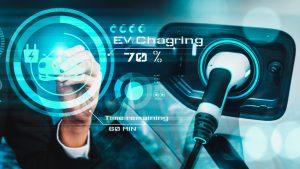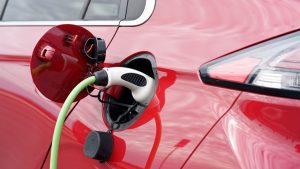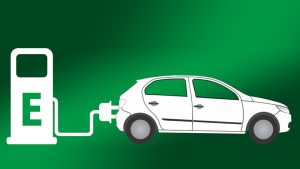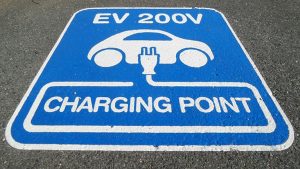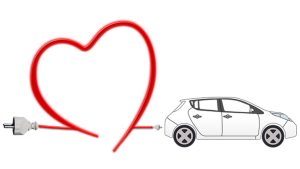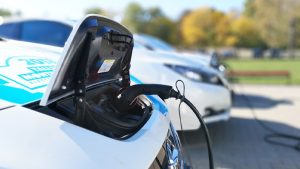EV Charging Infrastructure
Electric vehicle (EV) charging infrastructure, often referred to as electric vehicle supply equipment (EVSE), is at the core of the EV ecosystem. Essentially, it describes infrastructure for charging EVs. Similar to mobile network infrastructure that supports a comprehensive communication system for mobile telecommunications, EVSE is a comprehensive power supply and control system that supports charging piles for EVs.
The simplest EV charging station is an electronic device, usually in the form of wall-mounted or piles, that draws from the power grid to safely charge vehicle batteries. Different types of chargers offer varying current and voltage levels to satisfy the specific battery requirements of various vehicles, ranging from 500 watts (W) to 500 kilowatts (kW).
Most vehicles are equipped with on-board charger systems that convert alternating current (AC) from the power grid to the direct current (DC) required to charge batteries. On-board charger systems allow vehicles to directly charge using standard household plugs (slow alternating current) or dedicated AC chargers (medium speed alternating current) in the home, at the workplace, or in public places. Chargers that bypass converters and provide DC charging to vehicle batteries, known as DC chargers or DC fast chargers, are capable of providing faster charging speeds.
Charging equipment often has some level of smart capabilities, enabling it to offer user verification, vehicle communications, data collection and monitoring, and payment. Various models may be capable of 2-way control under some circumstances, adjusting the power level entering the batteries via a control system based on price signals or other control factors. Other chargers are sometimes called “dumb” chargers that lack any control of communication functionality. They simply adjust electricity from power grids to the current and voltage required by the receiving batteries.
Hardware Infrastructure of EV Charging Systems
Standard charging systems include the following basic hardware components:
- Power electronic components are at the core of charging stations. They provide power to the on-board battery chargers on EVs.
- Charging controllers, the smart equipment in charging stations, manage basic charging functions such as activating or deactivating the charger, monitoring power use, and saving critical real-time data for incidents.
- Network controllers offer broader network connectivity to charging stations. They allow charging stations to utilize telecommunications equipment and conduct network communications so that systems administrators can monitor, review and control the use of equipment. They can also manage user access to charging stations.
- Cables and connectors known as charging guns are inserted into vehicles to establish a safe physical connection between chargers and vehicles. Charging guns or connectors generally comply with specific standard formats of car OEMs (such as CCS, CHAdeMO, SAE J1772, IEC 60309).
- Data Management
EVs and EV chargers constantly generate important data related to battery charging status such as the charge rate of the battery, kilowatt-hour (kWh) used during charging, the power grid’s price signal, and requested response signals from management systems. Charging management software aims to manage and operate charging stations and their networks with efficiency and accuracy. Network software utilizes the 2-way data process between charging stations and their network control centers to effectively promote the rapid deployment and configuration of EV charging systems while explaining the remote configuration, management, and software updates performed by operators. Charging management software can set up and control drivers’ charging permissions, set prices, manage billing, and generate usage reports.
- Maintenance and Service
Like any piece of equipment subjected to continuous public usage, EV chargers require a degree of service and maintenance. Public charger services are generally the responsibility of their owners or operators, not the power companies that supply their power. However, power companies that own public charging stations are of course responsible for the regular service and maintenance of their property.
Development of EV Charging Technology
Before EVs, the expression “range anxiety” was unheard of. Today, you hear it mentioned in almost every conversation about EVs and their charging systems. While some people still worry that EV batteries lack the power required to reach their destinations, recent technological advances have greatly relieved “range anxiety”. These advances are empowering EV batteries with the charging capacity to charge faster, for longer.
Let’s look at recent developments in EV charging technology.
- Battery Storage
Household charging is relatively simple, since the costs incurred are simply added to homeowners’ energy bills and paid as usual. However, charging costs can be challenging for many employees who need to charge their vehicles at work, and for companies that rely on a large number of vehicles. The good news is, battery storage technology offers a solution that charges and stores energy during off-peak hours. During these periods of lower demand, tiered pricing is at a lower level. During peak periods of energy use, such as during work hours, the energy subsequently stored in batteries during off-peak hours effectively relieves the pressure on the power grid and on the user’s pocket, when load and prices are at their highest. Hence electricity costs are significantly reduced.
- Wireless Charging
It sounds almost too good to be true – the ability to charge vehicles wirelessly, similar to the way in which we can charge smartphones. Technological advances offer all kinds of possibilities. Massive objects like cars require a huge amount of charging power, which is obviously very different from directly placing a smartphone on a wireless charger. Among the many challenges are space and cost issues. For starters, wireless EV charging requires:
- An additional charger integrated into the vehicle, which increases vehicle cost
- Wireless chargers integrated into public places, which is extremely costly
- A shorter distance between chargers and vehicles for increased efficiency
Many vehicle and EVSE manufacturers such as Genesis/WiTricity, DKE, Project STILLE (Germany), and CATARC (China) are all pushing the limits of wireless EV charging technology.
- Megawatt Charging System (MCS)
Another advance in EV charging technology is high-performance charging that allows massive EVs such as heavy trucks and public transport vehicles to operate over longer distances. This is known as high-power megawatt charging. Like wireless RV charging, there are many barriers to overcome before widespread adoption will be possible. High-power megawatt charging systems (MCSs) require:
- High-capacity EV batteries and thicker cables to increase charging power
- Elevated safety standards due to higher charging loads
- Further increases in speed and efficiency (truly fast charging should complete 1MW of power within 15 to 20 minutes)
- Fast charging stations capable of simultaneously charging multiple vehicles
Megawatt charging technology is currently being applied to light electric aircraft, ferries, and some other ships. With the adoption of megawatt charging technology, battery storage will become critical for handling peak electricity demand in power grids.
- Mobile EV Charging
Mobile EV charging systems include portable chargers, charging cars or trailers, and temporary chargers. The advantage of mobile charging systems is that they eliminate the need for permanent charging infrastructure, and provide the flexibility of moving charging devices to wherever they are needed. This charging technology and solution is highly effective in specific scenarios such as charging EVs in car dealerships, or providing mobile charging via rescue vehicles for EVs that have run out of power on the road.
- Automatic EV Charging
While automatic and wireless charging are interchangeable to a certain extent, they differ in that wireless charging usually requires driver intervention, such as parking on a charging plate. Automatic charging, as its name implies, happens automatically without any driver input.
Imagine installing charging plates under road asphalt so that electric buses can charge on the move, or installing autonomous charging plates under the asphalt of parking lots or home garages. Automatic charging is especially important for self-driving cars, to allow them to be charged in diverse situations without human driver intervention. While it will still be several years before self-driving cars can operate on public roads, they are already in use in the loading zones of some container ports. Self-driving EV charging technology is being developed to keep pace with the growing demand.
Conclusion
Given the current focus on carbon emissions, carbon neutrality, and the electrification of roads, the development of EV charging infrastructure will undoubtedly accelerate. It is quite possible that automatic and wireless charging equipment will become relatively commonplace in the near future – allowing us to break free from our reliance on fossil fuels and embrace bluer skies, a cleaner environment, and better lives.




